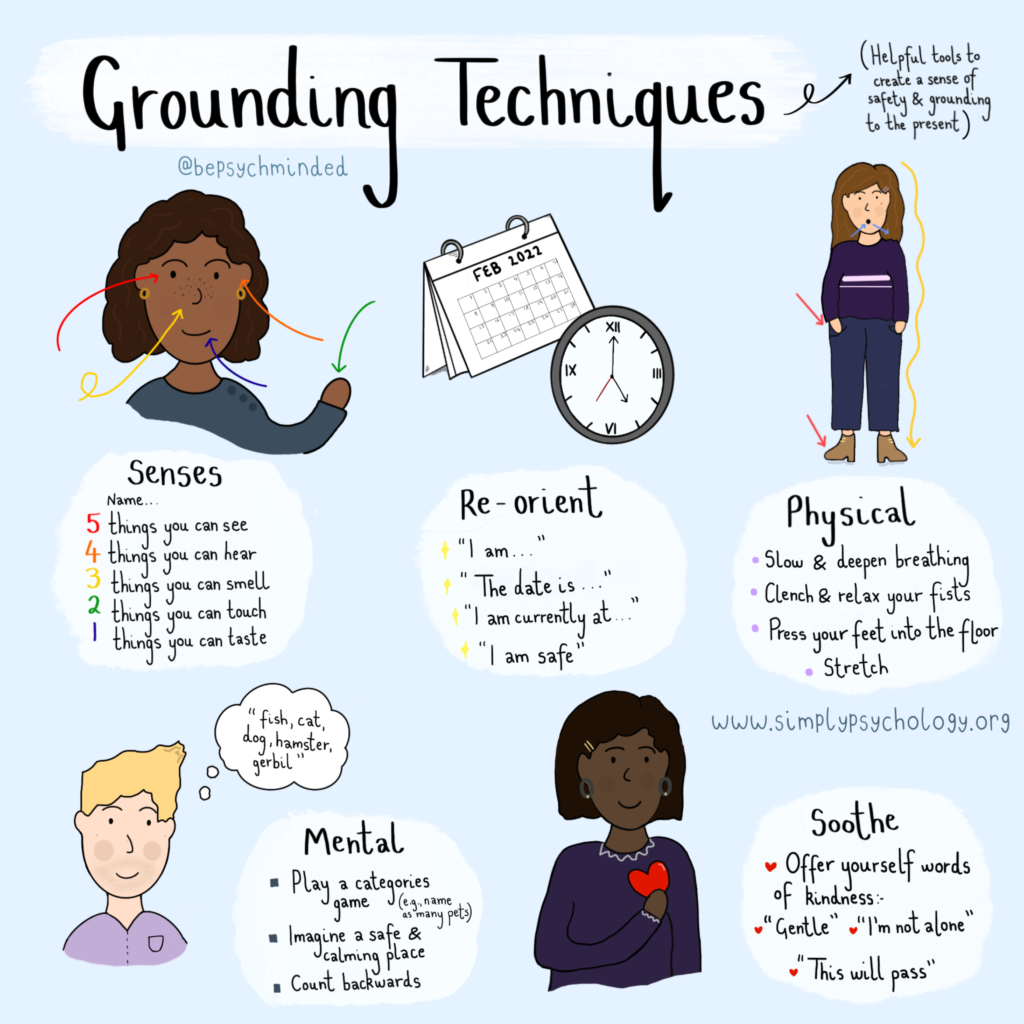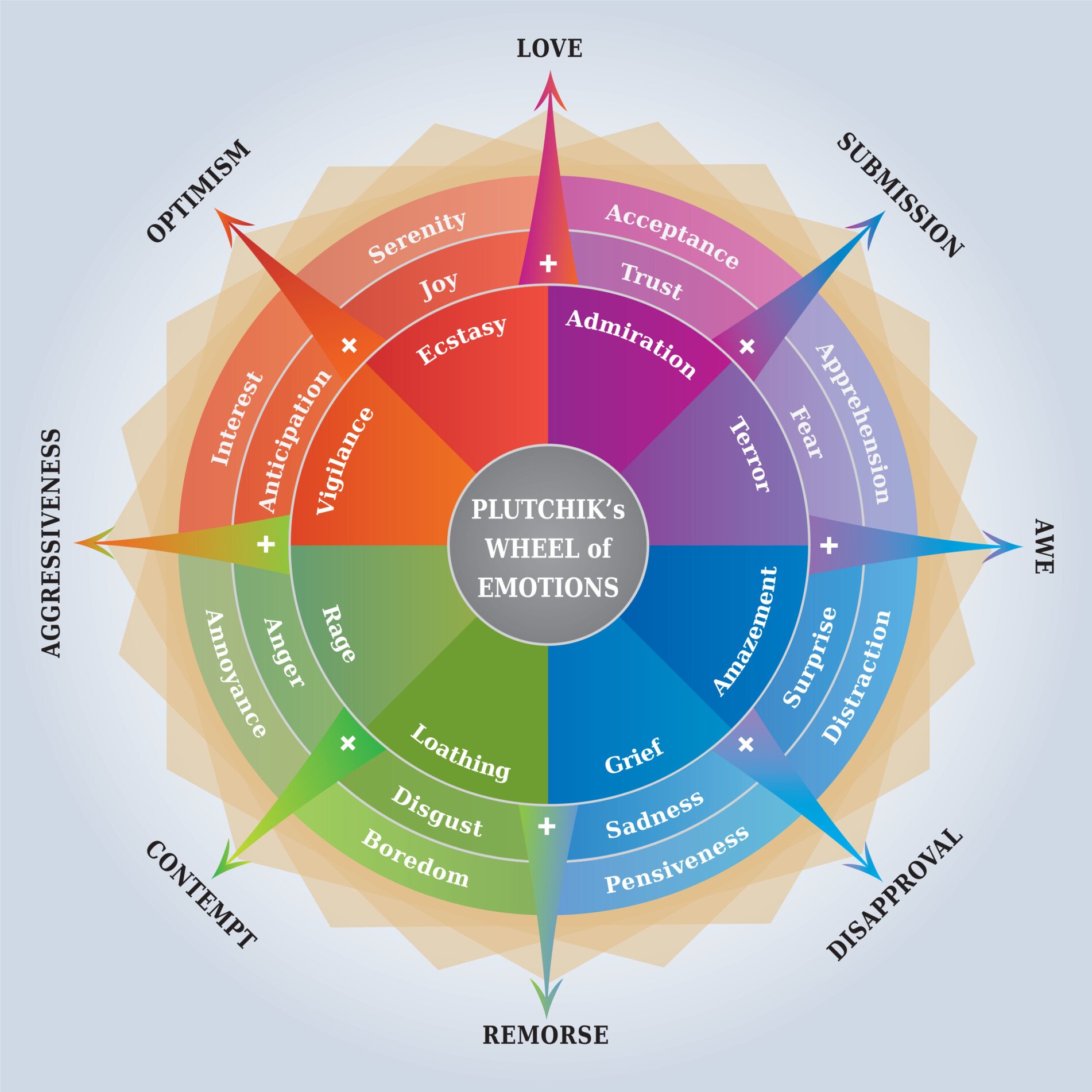Emotional dysregulation is a common challenge for many individuals with ADHD. The inability to effectively manage emotions can significantly impact daily functioning and quality of life.
Emotional outbursts, mood swings, irritability, and other affective symptoms of ADHD can strain social relationships and create difficulties in school, work, and family environments.
Without proper management, emotional dysregulation may also lead to worsening ADHD symptoms, anxiety, depression, and emotional exhaustion.
It is, therefore, critical for those with ADHD to develop strategies and skills to gain better control over their emotional responses.

Label the emotion
Begin the process of emotional management by identifying and naming the specific emotion you’re experiencing, as sometimes, simply acknowledging your feelings can help you gain better control over them.
When you can put a name to your emotions, they become less abstract and easier to manage. For example, if you are feeling anxious, recognizing it as anxiety can be the first step in addressing it effectively.
“I keep an “emotions diary” that’s separate from my regular diary, where I write about whatever that’s solely for dealing with the really intense emotions I get. It helps to plan and compartmentalize…”
‘Jesse’
Learn your triggers
Pay attention to situations or events that tend to trigger strong emotional responses. These triggers can vary greatly from person to person and may include things like public speaking, deadlines, crowded spaces, personal conflicts, etc.
Understanding your unique triggers allows you to prepare and develop strategies to cope when you encounter them.
By knowing what sets off your emotional responses, you can then be better equipped to manage or mitigate them.
“One way of dealing with strong emotion is simply not to put yourself in places where it’s likely to take place. Now that’s not always possible, but in the case of children and in some cases with adults it’s worth considering whether that would work…
We could start by situation selection which simply means take an inventory of the situations that commonly provoke strong emotion and then see whether or not you have the potential to avoid them or opt out of them.”
Dr Russell Barkley
Allow the emotion
Suppressing emotions tends to backfire. Emotion acceptance is about allowing yourself to feel without judgment or guilt. This prevents emotions from intensifying due to resistance.
According to Dr. Russ Harris’ ACT model, accepting distressing thoughts and emotions helps reduce their power over our actions.
By developing mindful, non-judgemental awareness of our momentary emotional state, we can allow emotions to flow through us without suppressing or over-identifying with them.
This emotional acceptance is not resignation – it simply means being present with your feelings rather than blocking them out or over-identifying with them. Allowing yourself to fully process emotions can support healthy regulation.
“We often don’t know when we are emotionally dysregulated, so if there is one thing I want you to remember, it’s try your best never to respond in the moment but let your emotions cycle through and come back into a place where you can pause breathe and think about things more rationally and then move forward from that point.”
Caren Magill, ADHD Coach.
“For me it’s usually best not to act at all instead it’s usually helpful to find somewhere quiet to take the time to sit with the emotion and process it and figure out how i want to respond to it.”
Ella
Listen to your body
Emotions often manifest physically, and emotional responses can trigger various physical sensations, like muscle tension, a racing heart, stomach discomfort, or shallow breathing.
Tuning into your body can thus provide early cues about your emotional state.
By recognizing these physical manifestations of emotions, you can gain insight into your emotional responses and take steps to manage them more effectively.
For example, if you notice muscle tension when you are angry, try practicing relaxation techniques like deep breathing to help alleviate this physical response and, in turn, the emotional intensity.
“Take a few deep breaths, and you automatically start to change the nature of your nervous system, moving out of the limbic brain into the prefrontal cortex.”
Caren Magill, ADHD Coach.
You can also consider therapy such as EMDR (Eye Movement Desensitization and Reprocessing). EMDR therapy uses bilateral stimulation like eye movements, taps, or sounds to activate the brain’s natural processing of memories and emotions, helping you gain clarity and insight into your feelings.
Reframe the situation
Try to reframe your perspective on the situation by considering alternative viewpoints or interpretations that may reduce the emotional impact.
This cognitive restructuring can help you see things more objectively and with greater emotional balance.
For example, if you have received constructive criticism at work, rather than taking it as a personal attack, you can reframe it as an opportunity for growth and improvement.
Some cognitive behavioral therapy (CBT) techniques on reframing thought patterns that you can try are:
- Catch it, check it, change it cycle
- Distance yourself from the emotion and critically reflect on what is worrying you (e.g., how likely is it that it will occur)
- Pretend that it is not you but one of your loved ones going through it. What would you advise them? How does the situation seem now that you are looking at it from an outside perspective?
- Catch yourself when you are going in unhelpful thought loops, e.g., all-or-nothing mentality, catastrophizing, etc.
Consider mindfulness
Mindfulness techniques, such as deep breathing exercises and meditation (Bueno et al., 2015), can help you stay present and regulate your emotions as they encourage a non-judgmental awareness of your thoughts and feelings.
Therefore, engaging in mindfulness practices can help you stay grounded and centered in the face of emotional turbulence.
Sydni, who has ADHD, gives her advice for how you can be more mindful:
“For the next week or so, when something happens that provokes an emotional response, just take note of it. Practice becoming more aware of what’s going on inside of you. You don’t need to change anything yet. Just practice becoming aware.”
From ‘What in the ADHD?’
By becoming more aware of your emotions and thoughts as they arise, you can respond to them with greater intention, control, and less impulsive reactivity.
Some DBT (Dialectical Behavior Therapy) mindfulness exercises you can try are:
- Sensory mindfulness, e.g., being present when eating or moving
- Deep breathing meditation
- Isolated focus on environmental and surrounding sounds
Redirect attention
Engaging in activities that divert your focus from overwhelming emotions, such as hobbies, physical exercise, or even a change of scenery, can effectively shift your attention away from distressing feelings.
This redirection of attention can help break the cycle of rumination and emotional overwhelm.
“Modify the situation – change where you’re sitting, change what you’re looking at, distract yourself and in other ways try to modify it so that it helps you regain control of yourself and the emotion.”
Dr Russell Barkley
For example, when you are feeling anxious, trying to go for a walk, or practicing a creative hobby to help provide a valuable distraction and reduce the intensity of your emotions.
You can try implementing grounding techniques such as the “5,4,3,2,1” (Shukla, 2020), which asks you to identify 5 things you can see, 4 things you can touch, 3 things you can hear, 2 things you can smell, and 1 thing you can taste.

Forgive yourself
Understand that it is normal to experience emotional dysregulation at times, so be kind and patient with yourself.
Try to avoid self-criticism, as it can exacerbate emotional distress, and remember that everyone has moments where they struggle to control their emotions, and it is all part of being human.
Thus, by forgiving yourself for experiencing emotional turbulence, you can allow yourself to approach your emotions with self-compassion and a more constructive mindset.
In CBT work, one exercise you can try, as suggested by Dr. Dawn-Elise Snipes, is “The 4 R’s for forgiveness” (Snipes, 2020):
- Responsibility
- Remorse
- Rectifying
- Release
You can watch the full YouTube video titled “The 4 Rs to Self Forgiveness: Cognitive Behavioral Therapy” to learn more in-depth.
Set Boundaries
Establish clear boundaries in your relationships and commitments, as setting healthy boundaries can prevent emotional overwhelm caused by taking on too much or dealing with difficult individuals.
It is thus essential to recognize your emotional limits and communicate them effectively to protect your well-being.
Having such clear boundaries can then help reduce stress and limit emotional triggers, enabling you to manage your emotions more effectively.
Setting clear boundaries is an important part of CBT. Reflecting on your needs and desired outcomes can help you determine healthy boundaries.
Ask yourself what approaches will support you in meeting your goals and which behaviors may hinder your progress or worsen situations (for example, remaining composed versus shutting down).
Maintain a Healthy Lifestyle
Prioritizing sleep, nutrition, and exercise as a well-balanced lifestyle can positively impact emotional resilience and regulation.
Inadequate sleep, poor nutrition, and a sedentary lifestyle can directly contribute to pooper emotional dysregulation, so it is important to make sure we are considering these factors.
Therefore, regular exercise, a balanced diet, and sufficient rest can enhance your emotional well-being. By prioritizing a healthy body, you can then better support your emotional regulation.
People can have different preferences in what works for them, so try a variety of activities until you find one you enjoy.
For example, some beginner-friendly exercises to consider are things like yoga, stretching, and mobility-focused workouts. Herbal teas such as chamomile can help with sleep, in addition to narrated stories or types of frequency noises such as white or brown noise.
Use Visual Aids
Visual tools, such as emotion charts or mood trackers, can help you recognize patterns in your emotional responses and assist in self-regulation.

By documenting your emotional experiences and the circumstances surrounding them, you can identify trends and triggers. This self-awareness can lead to more effective strategies for managing your emotions, monitoring your patterns, and progressing in your regulation goals.
These can come in a variety of ways, so depending on your preference, you can find some apps that help you track emotions, or if you prefer pen and paper, you can keep records of everything in a bullet journal.
FAQs
What can trigger emotional dysregulation?
Emotional dysregulation in ADHD can be triggered by various factors. Some key ones to highlight are:
- Stress: Work deadlines, relationship conflicts, or financial troubles
- Rejection or Criticism: This can be in personal or professional settings and may trigger intense emotional responses and feelings of inadequacy.
- Sensory Overload: Loud noises, bright lights, or crowded spaces
- Fatigue: Lack of sleep or mental exhaustion can lower emotional resilience
- Unpredictability: Sudden changes in plans, unexpected events, or disruptions to routines can be particularly challenging
- Personal Relationships: Relationship conflicts, misunderstandings, or difficult interactions with friends, family, or colleagues
- Negative Self-Perception: Perceived personal failures, negative self-talk, or self-esteem issues
- Overwhelm: Multiple tasks or responsibilities
- Physical Health: Physical discomfort or illness for themselves or a loved one
- Environmental Factors: Disorganization, clutter, or chaos
Do people with ADHD suppress emotions?
People with ADHD can often suppress their emotions in various situations.
For example, this can occur due to societal expectations, past negative experiences, fear of rejection, and misunderstandings resulting from emotional dysregulation.
Executive function challenges may also drive emotional suppression, helping individuals maintain control over their feelings.
Overstimulation and the need for impulse control contribute to this behavior, especially in overwhelming environments.
Work and academic settings can also lead to emotional suppression in terms of meeting performance, job, or grade expectations.
That being said, while suppressing emotions can be helpful in certain situations, it may lead to emotional bottling, increased stress, and potential mental health consequences like anxiety and depression.
Thus, recognizing such situations and seeking support or using coping strategies (such as therapy), can help individuals with ADHD in managing emotions more effectively.
What is alexithymia?
Alexithymia is a psychological condition characterized by difficulty identifying, understanding, and expressing emotions (Apfel & Sifneos, 1979). Due to challenges in recognizing their emotions, people with this condition may resort to using vague and general adjectives such as “I feel good/bad/okay” in an attempt to express how they are feeling.
Alexithymia can be common in individuals with ADHD (Edel et al., 2010) as well as in Autism (Kinnaird, Stewart & Tchanturia, 2019), personality disorders (Nicolò et al., 2011), etc.
“I can’t verbalize what it is that I’m feeling, which frustrates me even more because I can’t put the words to what I’m feeling… if I don’t know what’s wrong with me, then why in the world am I upset?”
From Ginapp et al. (2023).
The overgeneralization in describing emotions can impair their ability to regulate emotions effectively. It may mean they have trouble making sense of their more intricate emotions.
Similarly, they may struggle to empathize with others and have lower emotional intelligence. Consequently, social life, relationships, and interactions with others can be impacted and strained.
Can you have ADHD without emotional dysregulation?
While emotional dysregulation is often comorbid with ADHD, people can still be diagnosed with ADHD without having any significant emotional regulation struggles.
ADHD is a complex and heterogeneous condition, meaning it can manifest differently in different individuals. Therefore, some individuals with ADHD may experience emotional dysregulation more prominently, while others may not.
Primary symptoms of ADHD that are required for a diagnosis are focused on inattention, hyperactivity, and impulsivity with several ADHD subtypes stemming from these symptoms.
Emotional dysregulation is not a required symptom for an ADHD diagnosis, although it is commonly associated with the condition.
So while someone with ADHD may experience difficulties in managing emotions, they may not meet the criteria for emotional dysregulation.
Can ADHD emotional symptoms get worse with stress?
ADHD emotional symptoms can absolutely worsen with stress, as it can often exacerbate their existing symptoms and make it more challenging to manage their emotions. Some examples of stress impacting emotions are:
- Increased emotional reactivity
- Impaired emotional regulation
- Difficulty in concentration
- Worsening of comorbid conditions (e.g. depression)
- Impact on coping mechanisms
If you are experiencing significantly elevated levels of stress to the point that it is making your ADHD symptoms worse while directly impacting your daily life, there are several things you can try.
These range from trying some self-management habits like mindfulness and breathing exercises to ensuring you are having a balanced lifestyle and seeking professional help from a specialist.
References
Apfel, R. J., & Sifneos, P. E. (1979). Alexithymia: Concept and measurement. Psychotherapy and psychosomatics, 32(1-4), 180-190.
Arnsten, A. F., & Rubia, K. (2012). Neurobiological circuits regulating attention, cognitive control, motivation, and emotion: disruptions in neurodevelopmental psychiatric disorders. Journal of the American Academy of Child & Adolescent Psychiatry, 51(4), 356-367.
Bueno, V. F., Kozasa, E. H., da Silva, M. A., Alves, T. M., Louzã, M. R., & Pompéia, S. (2015). Mindfulness meditation improves mood, quality of life, and attention in adults with attention deficit hyperactivity disorder. BioMed Research International, 2015.
Edel, M. A., Rudel, A., Hubert, C., Scheele, D., Brüne, M., Juckel, G., & Assion, H. J. (2010). Alexithymia, emotion processing and social anxiety in adults with ADHD. European journal of medical research, 15, 403-409.
Friedman, L. A., & Rapoport, J. L. (2015). Brain development in ADHD. Current opinion in neurobiology, 30, 106-111.
Ginapp, C. M., Greenberg, N. R., MacDonald-Gagnon, G., Angarita, G. A., Bold, K. W., & Potenza, M. N. (2023). “Dysregulated not deficit”: A qualitative study on symptomatology of ADHD in young adults. Plos one, 18(10), e0292721.
Kinnaird, E., Stewart, C., & Tchanturia, K. (2019). Investigating alexithymia in autism: A systematic review and meta-analysis. European Psychiatry, 55, 80-89.
Nicolò, G., Semerari, A., Lysaker, P. H., Dimaggio, G., Conti, L., D’Angerio, S., … & Carcione, A. (2011). Alexithymia in personality disorders: Correlations with symptoms and interpersonal functioning. Psychiatry research, 190(1), 37-42.
Shukla, A. (2020). A 5-Step Mindfulness Grounding Technique To Ease Anxiety & Why Mindfulness Works. Cognition Today.
Snipes, D. E. (2020, December 30). The 4 Rs to Self Forgiveness: Cognitive Behavioral Therapy. [Video]. YouTube.


